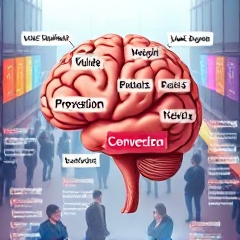Review of the book "Business Copywriting" - Denis Kaplunov. About creating effective texts
The author doesn't just share tips - he takes you by the scruff of the neck and whispers in your ear: "This is how you sell with words!"
- By page fifteen, you're searching for a pen to jot down how concisely, yet with deadly precision, he drives home a structure that works.
- Not theory for theory's sake, but practical formulas like "4U", "AIDA", and "PAS" - only in the author's own twist.
- With examples that hook stronger than a fishing hook.
- It's here that you realize copywriting is a strict precision, where an extra verb can cost a business thousands of rubles.
- Kaplunov is unforgiving: he's merciless towards clichés, worn-out metaphors, and "fluff" that we're all guilty of pouring out.
- His criticism is not a cold shower, but an icy waterfall that makes you want to survive, grow, and finally write in a way that makes the reader not just read, but buy.
Key Concepts and Their Analysis

He doesn't persuade - he dissects. In each section, high-quality elaboration is traced: the author doesn't just explain how effective text is structured, he seems to dissect the mechanism of a wristwatch and show where exactly the spring trigger is hidden, which triggers the desire to buy.
- Presentation structure: he builds a logical ladder, at each stage of which there is specificity: from a catchy hook to the last argument that leaves no choice but to click the "Place order" button.
- Emotions: this is fuel, but the roadmap is structure.
He reminds: if you don't know who your reader is, you're shooting in the dark. Kaplunov makes you turn on the flashlight and, more importantly, take aim.
Who is the book for
This is not bedtime reading or inspiring material for a cozy Sunday with a cup of tea - it's a working material, as sharp as a scalpel, and it's not intended for everyone, but for those who play high stakes on the field of meaning every day:
- marketers
- project owners
- digital strategists
- copywriters
The author doesn't waste time on idle talk - he talks to the reader as an equal, doesn't persuade, but demands: "Understand who you're writing for, or move on".
And this is not just a pose - it's a fighting spirit, supported by dozens of cases where hitting the pain, desire, or fear of the audience turned gray pages into sales machines.
While reading, you catch yourself feeling like you're walking through a minefield - one step to the left, one step to the right, and you lose the client's attention. But if you follow the author - behind these "ifs", "because", and "that's why" - you can catch that very spark of understanding when the text ceases to be a set of phrases and becomes a dialogue.
This is a guide for those who don't just want to "write beautifully", but intend to sell, convince, and retain.
And if you're not ready to look into the reader's eyes, to recognize their reflexes, you're not the target audience - and the book will throw you overboard.
About the author and his significance in marketing

He is not one of those who came to the market yesterday and is trying to sell air in a beautiful package — behind him is not just years, but a whole era of writer's hardening at the forefront of business, where every word either brings profit or dies without reaching the "Send" button. Denis is not a "guru" with loud slogans, but rather a surgeon of meanings: he cuts out the unnecessary, stitches the necessary, and revives the dead.
There is no room for lyrics for the sake of lyrics in his approach — he is a master who sharpens every sentence like a turner sharpens a detail, so that it fits into the sales system without play. His name has long become a password among those who know how to sell with text:
- from lone freelancers
- to agency owners who order not "texts" from him, but points of influence.
This is a person whose ideas have become embedded in the thinking of thousands of specialists, and whose articles, like combat leaflets, have spread across laptop screens and become a desk bible for those who work on conversion, not likes. His significance is not in loud headlines, but in the fact that he knows how to talk about the obvious in a way that makes you suddenly understand: you never really knew that.
The Place of the Book in Modern Marketing Literature
Against the backdrop of countless "guides" with loud titles and empty content, this book stands like a bronze lion at the entrance to a library — not for decoration, but as a sign: here is something to lean on.
In a world where marketing publications proliferate so quickly that you don't have time to dust off the previous purchase, this work is not just another cover on the shelf, but an anchor to return to after a dozen disappointments.
It doesn't just retell — it offers concrete actions. Unlike authors prone to imagery and general reasoning, this book presents a clear and systematic approach: analysis of the text structure, argumentation logic, and presentation features. The author shares not abstract ideas, but practical solutions applicable in real work with text.
It's no surprise that the book has become part of the canon of professional literature as a mechanism, not decoration: people read it not to "get inspired," but to survive in the struggle for client attention.
And when you see how it combines analytical clarity and practical courage, it becomes clear: this is not just a word about text — this is text that knows how to sell itself.
| Criterion | Book | Other Publications |
|---|---|---|
| Content | In-depth analysis | Superficial approach |
| Practical Application | Tool for work | For inspiration |
| Style of Presentation | Surgical precision | Metaphors and banalities |
Relevance of the publication at the current moment

If earlier it was possible to slap together some text on your knee and send it into battle, relying on the power of the title and luck, today it's like stepping into the ring in slippers against an MMA fighter — no chance. In conditions where the feed is full of clichés, and user attention is measured in seconds, materials like this become not a luxury, but a necessity.
- Especially now, when every second entrepreneur is suddenly an «expert in content»,
- and every third agency promises «unique texts with high conversion» and throws around terms without understanding their meaning.
It's precisely in such an environment that this book feels like a bucket of ice water after a marathon — it sobers you up, structures and shows that behind a successful text stands not inspiration, but calculation, method, and knowledge of the reader's psychology. It's not just timely — it's like a survival guide in digital chaos, where those who can't speak clearly and to the point turn into background noise.
- Take, for example, the analysis of the target audience:
- the author doesn't limit themselves to banal «make a portrait of the client»,
- but demands detailed elaboration — down to motivations, fears, and the level of digital literacy.
This is not just a book on the topic — it's a shield and sword for those who work in a turbulent reality, where a word either sells or falls into a black hole of indifference.
Fundamental Marketing Concepts

But what's most striking is how the author extracts from the depths of marketing theory what many consider to be "obvious" and dissects it with the precision of a forensic expert.
- No room for vague formulations: every term, from "value proposition" to "conversion," is put through the meat grinder of practical analysis.
- Not just "here's a formula," but "here's how it works when real money is on the line."
- The difference between a "feature" and a "benefit": a feature is "what it does," and a benefit is "why it should matter to a buyer with three kids, a mortgage, and 20 seconds before closing the tab."
- Fundamental things: here they gain a skeleton, muscles, and even a pulse.
This is the strength of the book: it doesn't offer another "life hack" but returns to the origins, not like a museum guide, but like a coach who makes you push through every theoretical mistake.
Innovative ideas and modern trends
And here begins the real alchemy — when the old good craftsmanship turns into something that vibrates in tune with the digital age. What is presented in other books as dry statistics or another "trend for the sake of trend" comes to life here and is embedded in the living fabric of business.
The author does not just mention, say, neuromarketing or personalization — he digs into the essence: how exactly user behavior changes, when the headline "speaks" in their language, and the call-to-action button doesn't shout, but whispers in the ear.
It is impressive how organically the methods are woven:
- micro-targeting
- behavioral analysis
— without tediousness, with examples where real traffic and tangible budgets are at stake.
At some point, you catch yourself thinking that you're not reading, but rather participating in a master class, where every paragraph is a challenge, not just information.
Applicability of concepts in modern business
Here begins the real game on the strings of reality: the described techniques are not just theoretically possible - they work, and they work in such a way that you feel like a conductor in the orchestra of digital influence. This is precise and thoughtful work with text, where every word has a function, and every paragraph serves a specific purpose.
The example with a mailing list for a B2B company is particularly sobering:
- A slightly modified email structure (just moved the block with the client's pain up!)
- Several times increase in responses
Such details not only inspire, they make you rethink how we communicate with the audience. It's not about "writing beautifully", it's about "speaking so that people listen and act".
| Method | Effect | Icon |
|---|---|---|
| Replacing a phrase | +increase in clickability | |
| Changing the email structure | +increase in responses |
This is where the true applicability lies - when book theory is not gathering dust on a shelf, but becomes part of daily business decisions, from a startup's landing page to email funnels in a large corporation.
Case studies and examples from real business
And here it's not just a demonstration of success — it's almost an anatomy of influence, broken down into layers: you're not just reading about successful solutions, you're feeling how they click into place in your head, like puzzle pieces in a perfectly constructed mosaic.
- Example with a SaaS-service: reworking a standard landing page with a focus on a specific client pain point instead of dry product characteristics increased conversion.
- Case with a law firm: abandoning cliches and switching to a live style of addressing the client led to a threefold increase in applications within two months.
And perhaps it's in these stories that the most powerful aspect of the book is revealed: not in the fact that it teaches, but in the fact that it un-teaches — un-teaches banality, facelessness, and the fear of being truly heard.
Strengths of the publication
Every successful decision here is not just a line in a textbook, but a nerve through which an electric impulse of meaning passes. The book grabs the reader's attention most precisely where it ceases to be a "textbook" and becomes a mirror: not in the sense of "this is how you should do it," but "can you do it like that?".
What's particularly impressive is how the author takes away the reader's crutches —
- verbosity
- impersonal expressions
- ritual "unique advantages"
This is not theory; it's as if you were standing behind a master's shoulder as they turn raw text into a sharp tool:
- sharpening it to razor-sharp precision
- cutting out the unnecessary
- testing for bounce
For example, in the section describing the transformation of a client appeal from "our services" to "your benefits," you don't just read — you physically feel the air in the sentence becoming denser.
This is not a collection of techniques or superficial tips — it's a systematic approach to working with text. The book's main value lies in its rigor, attention to wording, semantic pauses, and context: it doesn't just teach, but shapes the reader's professional thinking and skills for independent work with text.
Critical Analysis
However, with all the fine-grained cutting of meanings, there were some cracks in the marble:
- At times, it feels that the author is so carried away with demonstrating their skill that they forget about the reader as a living person.
- In some chapters, the text starts to sound like a monologue of a self-assured lecturer who no longer asks "is it clear to you?" but just nods to themselves in the mirror.
- This is especially noticeable in blocks where discussions about the text structure turn into something like a checklist for internal verification.
- A paradox arises: a book designed to teach sensitivity to the target audience sometimes loses contact with the reader.
- It's as if, while being carried away with adjusting the lens, it forgets where it's pointing.
This imbalance doesn't destroy the construction, but makes you wonder:
- Where is the boundary between professional precision and human warmth?
- Are we at risk, having trained to automatism, of losing that very spark for which it all started?
Tools and techniques for practical use
But it is worth admitting: when the author finally switches from internal monologue to a live transfer of experience, real alchemy begins - solutions are born from dry formulas that you want to try out in the field right away. The module on segmentation of reader pain is especially impressive - not just a collection of banal tips, but a clearly structured mechanism, where every link is like a detail in Swiss watches.
- "3R" technique (recognize, resolve, offer a solution) is presented not as another abstract acronym, but through a case from the B2B sector:
- Campaign to promote a SaaS product, where due to competent diagnosis of objections, it was possible to increase the conversion of the landing page within two months.
And at this moment, you are not just reading - you feel how the methods that really work are igniting in your hands. True, as in any craft, without personal polishing, they can turn into dull cliches: the author honestly warns about this, but between the lines - in the spirit of a strict mentor, not an accomplice.
It is here that ambivalence is born: on the one hand, you have a set of honed techniques, on the other hand, you feel like you have been given a Stradivari violin, but are not allowed to play your own.
| Parameter | Description | Result |
|---|---|---|
| "3R" technique | Method of diagnosing objections | +conversion growth |
| Increasing conversion | Successful B2B campaign | +2 months |
Popularity of the present edition

Despite its apparent niche, this publication has long gone beyond the framework of a closed textbook for marketing craftsmen - it has been distributed to the offices of startup founders, agency team leads, and even university professors looking for living flesh instead of dusty theories.
- According to Ridero, the total number of downloads has exceeded 60 thousand.
- In professional communities like “Копирайтерский Чат” (Copywriter’s Chat) and “Маркетинг без купюр” (Marketing without Cuts), the book is mentioned in every fifth discussion about sales texts.
- The true measure of its influence is not numbers, but how the conversation about it sounds: not like a review of what was read, but like a reference to a generally accepted standard.
People quote its chapters without looking back, as if they are referring to sacred scripture for digital merchants. And here a strange feeling arises: you seem to be holding a specific book in your hands, but you feel that you are touching something bigger - an informal code of new rhetoric, which is no longer discussed because it has become the background.
Other works by the author
Denis Kaplunov is a well-known Russian copywriter and marketer, author of popular courses and books on creating sales texts and content marketing. In addition to the book "Business Copywriting", among his notable works and projects:
- "Sales Content" — a training course dedicated to creating effective texts for sales and marketing, widely in demand among professionals and entrepreneurs.
- "Constructor of Sales Text" — a course on working with texts and content, aimed at developing skills in creating powerful sales materials.
These works do not repeat each other, they form an ecosystem in which each new edition is not a remix, but a solo album with its own intonation.
And if you read all this in a row, the effect is that you're not just studying copywriting, but rather undergoing an initiation into a closed order of sales words, where Kaplunov is not a guru, not a coach, but rather a stubborn alchemist turning banal phrases into ringing currency.
Comparison with other works by the author
Against the backdrop of the author's previous publications, this work resembles a mature oak among lush undergrowth — it has grown, strengthened, shed the husk of youthful bravado, and stands confidently, with a shade in which a practitioner can comfortably take shelter. If earlier the reader received bright flashes of ideas, now they are presented with a meticulously crafted canvas, with carefully stitched arguments and without excessive pomp. There is no room for improvisations on the theme of “it will somehow work” — only cold logic, honed on hundreds of cases and supported by numbers that do not lie.
There was a time when the author accurately hurled formulas, like snowballs during a break, but in this work, they are more like an architect: building a system where every word is a load-bearing beam, not just trinkets for presentation. Compared to their early works, where the bravado of a pioneer was sometimes felt, here one hears the voice of a mature craftsman, who has passed through the thorns of feedback and deadlines.
This is not evolution for the sake of fashion, not an attempt to “modernize,” but the result of scrupulous work on mistakes, of which there were not many, but the author managed to extract benefit even from that.
| Criterion | Early works | New work |
|---|---|---|
| Style | Bravado | Logic |
| Approach | Improvisation | System building |
| Experience | Initial experience | Mature craftsman |
| Goal | Evolution for the sake of fashion | Work on mistakes |
Similar literature by other authors
If you look broader, at the neighboring books on the same shelf — from the works of Austin Kleon to the methodical analysis of Ann Handley — it becomes clear: everyone has their own fuel.
- Some juggle inspiration,
- some sell checklists,
- while others, like Joe Sugarman, bewitch with the hypnosis of storytelling.
But against the background of these names, the book by Kaplunov looks not like another manifesto “write as you breathe”, but like an engineering drawing, where emotions do not cancel out detail, and structure is more important than rhyme.
- Handley cares about tone,
- Kleon has a cult of creative audacity,
- Sugarman has the magic of the first line,
- and here — a nearly mathematical model, where every variable works for conversion.
And if most analogues offer “feel how it works”, here you won’t be let go until you understand why it works.
Among all this diversity of approaches — from inspiring to instructive — Kaplunov's work is felt like a professional mechanism: not to admire, but to tighten the nut in business.
This is not a coffee shop book where it's nice to sit, but a workshop book where it smells like shavings and you can hear the sound of metal being worked on.
